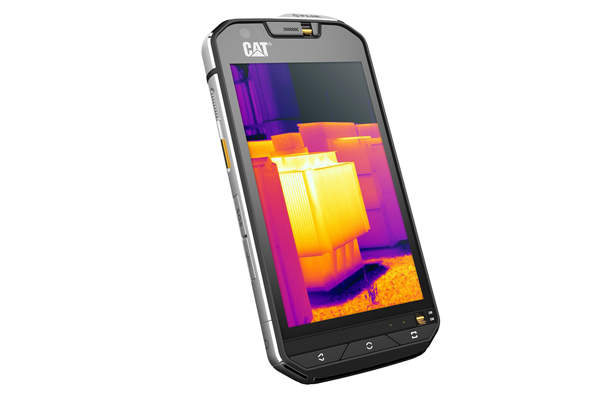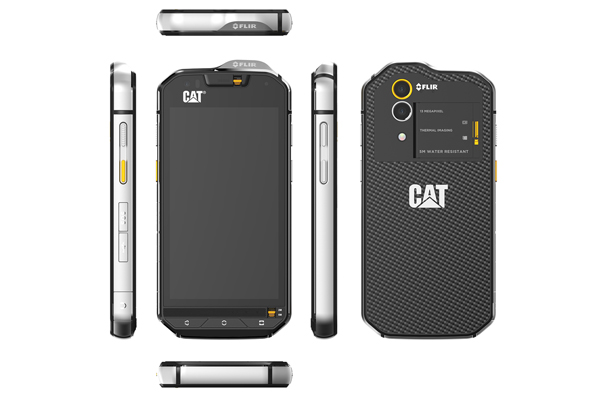CAT S60 is the latest in a catalog of rugged phone for Caterpillar products, for several years, is engaged in the commercialization of smartphones and feature phones for use in scenarios where reliability and ability to withstand harsh environmental conditions represent elements essential. Products certainly not facing the consumer market, which, at the same time, integrate features that do not fail to excite the curiosity of the techno fans.
Are two specifications that allow the CAT S60 to switch to the headlines: it is, in fact, the first smartphone in the world equipped with a thermal camera and, secondly, a terminal which has a unique resistance to liquids in the category: it can stand immersed in the liquid at a maximum depth of five meters per hour.
CAT has substantially integrated into the smartphone body thermal camera developed by FLIR. Specifically, the camera lets you view real-time thermal representation of the scene framed by the objective, measure the temperature of the surface and capture the scene in both photos, both videos. The resolution of the captured material in thermal mode, limited to 640 x 480 pixels (VGA), suggests what is the main purpose of the cam assessable on utility practice plan. CAT illustrates some scenarios where the use of the thermal cam is very useful, regardless of the resolution of the sensor: think of the activity of a team engaged in the search for the missing in a rescue mission that takes place in inaccessible scenarios, the forces of police who may use it in the investigation by measuring, for example, the temperature of the tires or the engine of a car for feedback on the statements of the subjects involved in the case, to arrive to the use in the building sector, thermohydraulic, etc.
The rest of the hardware profile highlights the typical canons of construction of rugged products, designed to withstand any external stress. The CAT S60 incorporates a reinforced frame that allows him to overcome unscathed falls from a height of 1.8 meters, incorporates a touch screen protected by glass Gorilla Glass 4 - manageable even with gloves - and a large 3800 mAh battery. Software soul is the Android operating system Marshmallow. The detailed hardware report includes:
Display 4.7 "HD multitouch, 540 nits, Gorilla Glass 4
SoC Snapdragon 617 octa-core
3GB of RAM and 32GB of storage
13mp rear camera with dual LED flash
Front 5MP camera
4G LTE connectivity
3800 mAh battery
High quality sound (> 105dB)
App of the FLIR thermal camera management with MSX technology
Are two specifications that allow the CAT S60 to switch to the headlines: it is, in fact, the first smartphone in the world equipped with a thermal camera and, secondly, a terminal which has a unique resistance to liquids in the category: it can stand immersed in the liquid at a maximum depth of five meters per hour.
CAT has substantially integrated into the smartphone body thermal camera developed by FLIR. Specifically, the camera lets you view real-time thermal representation of the scene framed by the objective, measure the temperature of the surface and capture the scene in both photos, both videos. The resolution of the captured material in thermal mode, limited to 640 x 480 pixels (VGA), suggests what is the main purpose of the cam assessable on utility practice plan. CAT illustrates some scenarios where the use of the thermal cam is very useful, regardless of the resolution of the sensor: think of the activity of a team engaged in the search for the missing in a rescue mission that takes place in inaccessible scenarios, the forces of police who may use it in the investigation by measuring, for example, the temperature of the tires or the engine of a car for feedback on the statements of the subjects involved in the case, to arrive to the use in the building sector, thermohydraulic, etc.
The rest of the hardware profile highlights the typical canons of construction of rugged products, designed to withstand any external stress. The CAT S60 incorporates a reinforced frame that allows him to overcome unscathed falls from a height of 1.8 meters, incorporates a touch screen protected by glass Gorilla Glass 4 - manageable even with gloves - and a large 3800 mAh battery. Software soul is the Android operating system Marshmallow. The detailed hardware report includes:
Display 4.7 "HD multitouch, 540 nits, Gorilla Glass 4
SoC Snapdragon 617 octa-core
3GB of RAM and 32GB of storage
13mp rear camera with dual LED flash
Front 5MP camera
4G LTE connectivity
3800 mAh battery
High quality sound (> 105dB)
App of the FLIR thermal camera management with MSX technology
Cat S60 will be exhibiting at Mobile World Congress in Barcelona, appointment suitable to touch the product with hands, but the company has already announced the sale price and date of availability: 649 € and a timetable providing for its arrival within the end of the year.


Comments
Post a Comment